Improving Workplace Communication: A Skills Development Plan
VerifiedAdded on 2020/05/16
|30
|5495
|115
Homework Assignment
AI Summary
This assignment is a self-assessment of workplace communication skills, utilizing various diagnostic tools to identify strengths and weaknesses. The student evaluated their non-verbal immediacy, talkaholic tendencies, intercultural communication apprehension, public speaking anxiety, and self-perceived communication competence. The results revealed a need for improvement in non-verbal immediacy and intercultural communication skills. The student provides personal experiences illustrating the impact of these communication deficits in professional settings, including team leadership and interactions with diverse colleagues and clients. Based on these findings, the student plans to develop an action plan to address these weaknesses, aiming to enhance their ability to communicate effectively, build positive relationships, and succeed in the workplace. The assignment also incorporates a literature review on the importance of non-verbal immediacy in communication, referencing studies that highlight its impact on interpersonal relationships, learning outcomes, and perceptions of individuals in professional settings. The student aims to transform weaknesses into strengths through a structured improvement plan.
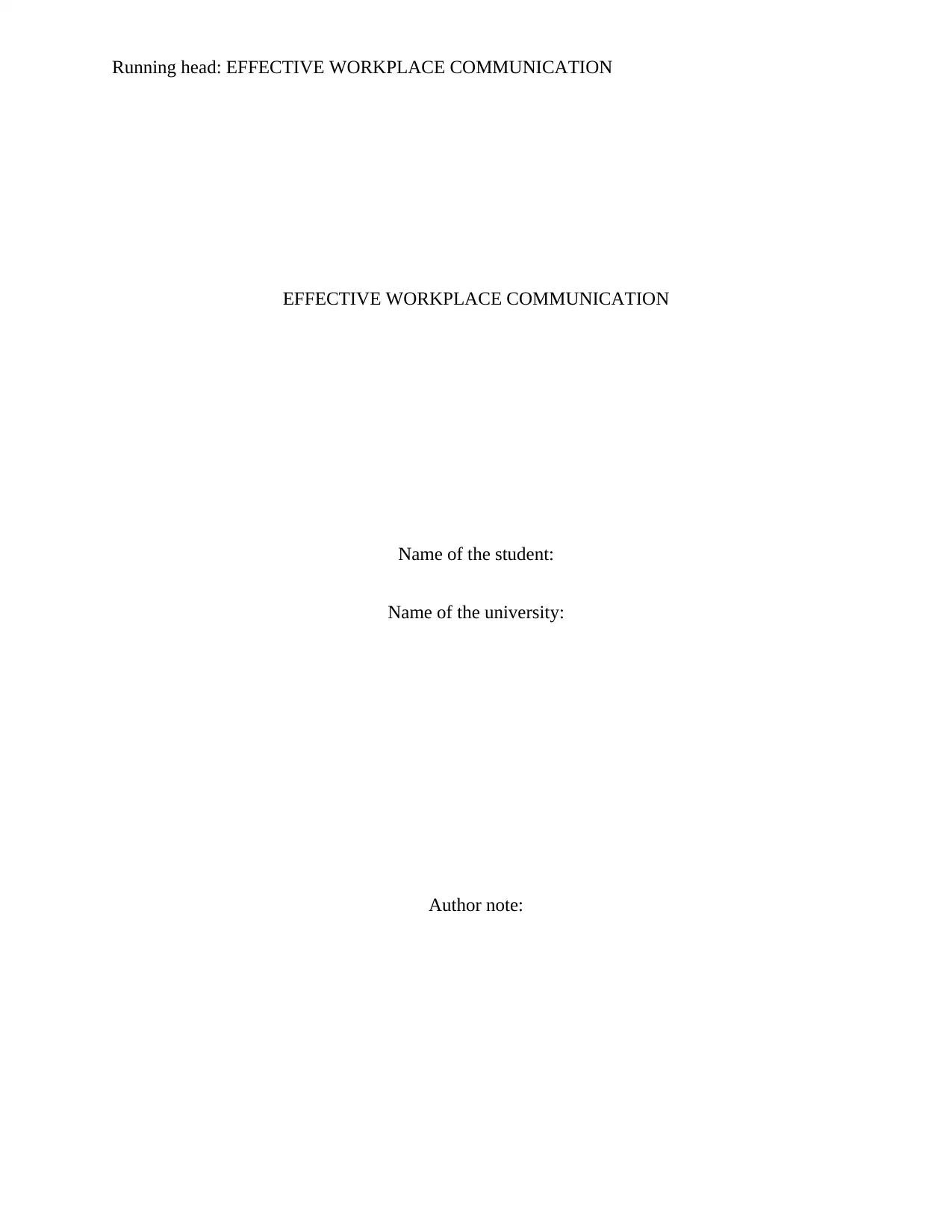
Running head: EFFECTIVE WORKPLACE COMMUNICATION
EFFECTIVE WORKPLACE COMMUNICATION
Name of the student:
Name of the university:
Author note:
EFFECTIVE WORKPLACE COMMUNICATION
Name of the student:
Name of the university:
Author note:
Paraphrase This Document
Need a fresh take? Get an instant paraphrase of this document with our AI Paraphraser
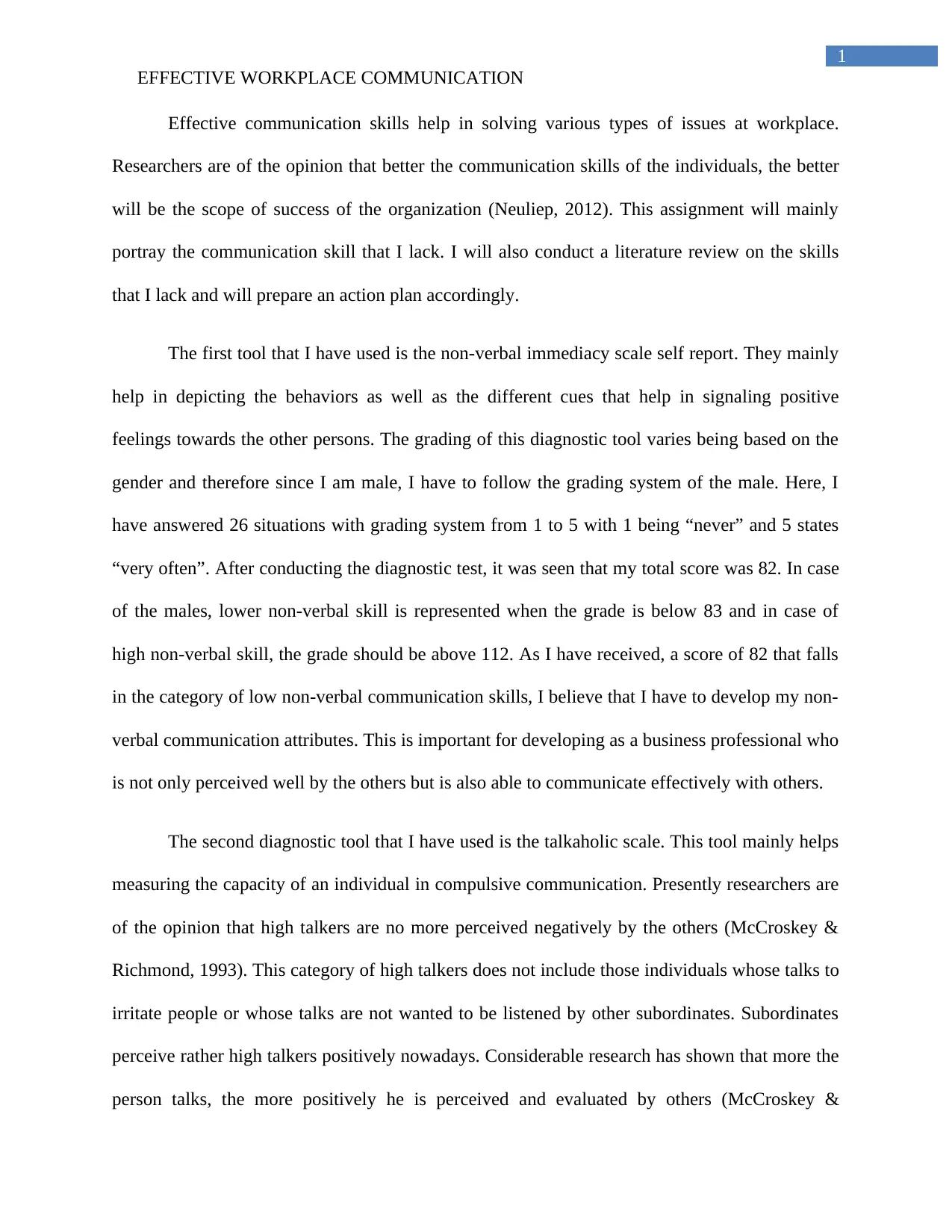
1
EFFECTIVE WORKPLACE COMMUNICATION
Effective communication skills help in solving various types of issues at workplace.
Researchers are of the opinion that better the communication skills of the individuals, the better
will be the scope of success of the organization (Neuliep, 2012). This assignment will mainly
portray the communication skill that I lack. I will also conduct a literature review on the skills
that I lack and will prepare an action plan accordingly.
The first tool that I have used is the non-verbal immediacy scale self report. They mainly
help in depicting the behaviors as well as the different cues that help in signaling positive
feelings towards the other persons. The grading of this diagnostic tool varies being based on the
gender and therefore since I am male, I have to follow the grading system of the male. Here, I
have answered 26 situations with grading system from 1 to 5 with 1 being “never” and 5 states
“very often”. After conducting the diagnostic test, it was seen that my total score was 82. In case
of the males, lower non-verbal skill is represented when the grade is below 83 and in case of
high non-verbal skill, the grade should be above 112. As I have received, a score of 82 that falls
in the category of low non-verbal communication skills, I believe that I have to develop my non-
verbal communication attributes. This is important for developing as a business professional who
is not only perceived well by the others but is also able to communicate effectively with others.
The second diagnostic tool that I have used is the talkaholic scale. This tool mainly helps
measuring the capacity of an individual in compulsive communication. Presently researchers are
of the opinion that high talkers are no more perceived negatively by the others (McCroskey &
Richmond, 1993). This category of high talkers does not include those individuals whose talks to
irritate people or whose talks are not wanted to be listened by other subordinates. Subordinates
perceive rather high talkers positively nowadays. Considerable research has shown that more the
person talks, the more positively he is perceived and evaluated by others (McCroskey &
EFFECTIVE WORKPLACE COMMUNICATION
Effective communication skills help in solving various types of issues at workplace.
Researchers are of the opinion that better the communication skills of the individuals, the better
will be the scope of success of the organization (Neuliep, 2012). This assignment will mainly
portray the communication skill that I lack. I will also conduct a literature review on the skills
that I lack and will prepare an action plan accordingly.
The first tool that I have used is the non-verbal immediacy scale self report. They mainly
help in depicting the behaviors as well as the different cues that help in signaling positive
feelings towards the other persons. The grading of this diagnostic tool varies being based on the
gender and therefore since I am male, I have to follow the grading system of the male. Here, I
have answered 26 situations with grading system from 1 to 5 with 1 being “never” and 5 states
“very often”. After conducting the diagnostic test, it was seen that my total score was 82. In case
of the males, lower non-verbal skill is represented when the grade is below 83 and in case of
high non-verbal skill, the grade should be above 112. As I have received, a score of 82 that falls
in the category of low non-verbal communication skills, I believe that I have to develop my non-
verbal communication attributes. This is important for developing as a business professional who
is not only perceived well by the others but is also able to communicate effectively with others.
The second diagnostic tool that I have used is the talkaholic scale. This tool mainly helps
measuring the capacity of an individual in compulsive communication. Presently researchers are
of the opinion that high talkers are no more perceived negatively by the others (McCroskey &
Richmond, 1993). This category of high talkers does not include those individuals whose talks to
irritate people or whose talks are not wanted to be listened by other subordinates. Subordinates
perceive rather high talkers positively nowadays. Considerable research has shown that more the
person talks, the more positively he is perceived and evaluated by others (McCroskey &

2
EFFECTIVE WORKPLACE COMMUNICATION
Richmond, 1995). They are more likely to be preferred as the leader by their subordinates as they
seem more competent to them. Therefore, better the grade of the scale better is my chance of
becoming an effective leader. There are 16 situations which I needed to fill with a scale of
numbers from 1 to 5 where 1 denoted strongly disagree to 5 being strongly agree. I scored a
value of 17 after the entire calculation. I saw that 17 lay in the category of low line talkaholics.
The grades between the 30 and 39 are considered as borderline talkaholics and the score above
40 is marked as compulsive talkaholics. Therefore, I believe that I really possess a very low
score and I need to develop my speaking skills, feedback giving and receiving skills, my social
skills effectively so that I am positively perceived by all.
The next diagnostic tool that I have used is called the Personal Report of the Intercultural
Communication apprehension called PRICA. This tool mainly helps in measuring the anxiety
that is developed by an individual when they try communicating with employees of other
cultures (Neuliep & McCroskey, 1997). Individuals mainly need to fulfill 14 important situations
by a grading scale from 1 to 5. Here, 1 indicates ‘strongly disagree’ and 5 indicate ‘strongly
agrees’. After completing the scale, I saw that I scored 27. The scoreboard said that when the
score is below 32, it indicates that the individual has low intercultural communication
apprehension (CA). When the score is between 32 and 52, it states that the individual has
moderate level of intercultural CA. When the score is above 52, it shows that the individuals
have high intercultural CA. My score falls in the category of low intercultural CA. Therefore, it
is very important for me to develop proper knowledge about how to develop intercultural
communication skills so that I can become an expert professional.
The next tool that I have used is called the Personal Report of Public speaking anxiety.
This tool mainly helps the individuals to measure their public speaking anxiety that they develop
EFFECTIVE WORKPLACE COMMUNICATION
Richmond, 1995). They are more likely to be preferred as the leader by their subordinates as they
seem more competent to them. Therefore, better the grade of the scale better is my chance of
becoming an effective leader. There are 16 situations which I needed to fill with a scale of
numbers from 1 to 5 where 1 denoted strongly disagree to 5 being strongly agree. I scored a
value of 17 after the entire calculation. I saw that 17 lay in the category of low line talkaholics.
The grades between the 30 and 39 are considered as borderline talkaholics and the score above
40 is marked as compulsive talkaholics. Therefore, I believe that I really possess a very low
score and I need to develop my speaking skills, feedback giving and receiving skills, my social
skills effectively so that I am positively perceived by all.
The next diagnostic tool that I have used is called the Personal Report of the Intercultural
Communication apprehension called PRICA. This tool mainly helps in measuring the anxiety
that is developed by an individual when they try communicating with employees of other
cultures (Neuliep & McCroskey, 1997). Individuals mainly need to fulfill 14 important situations
by a grading scale from 1 to 5. Here, 1 indicates ‘strongly disagree’ and 5 indicate ‘strongly
agrees’. After completing the scale, I saw that I scored 27. The scoreboard said that when the
score is below 32, it indicates that the individual has low intercultural communication
apprehension (CA). When the score is between 32 and 52, it states that the individual has
moderate level of intercultural CA. When the score is above 52, it shows that the individuals
have high intercultural CA. My score falls in the category of low intercultural CA. Therefore, it
is very important for me to develop proper knowledge about how to develop intercultural
communication skills so that I can become an expert professional.
The next tool that I have used is called the Personal Report of Public speaking anxiety.
This tool mainly helps the individuals to measure their public speaking anxiety that they develop
⊘ This is a preview!⊘
Do you want full access?
Subscribe today to unlock all pages.

Trusted by 1+ million students worldwide
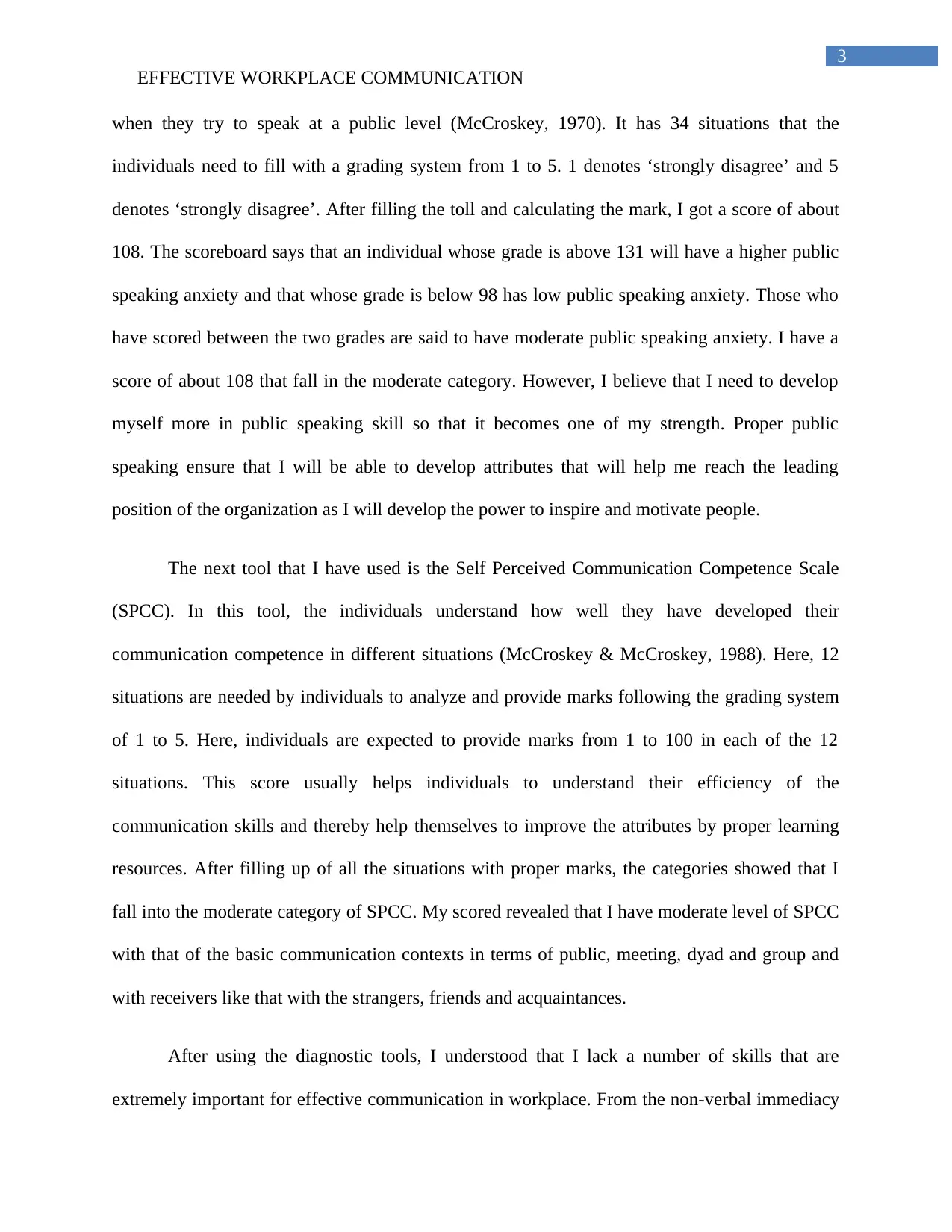
3
EFFECTIVE WORKPLACE COMMUNICATION
when they try to speak at a public level (McCroskey, 1970). It has 34 situations that the
individuals need to fill with a grading system from 1 to 5. 1 denotes ‘strongly disagree’ and 5
denotes ‘strongly disagree’. After filling the toll and calculating the mark, I got a score of about
108. The scoreboard says that an individual whose grade is above 131 will have a higher public
speaking anxiety and that whose grade is below 98 has low public speaking anxiety. Those who
have scored between the two grades are said to have moderate public speaking anxiety. I have a
score of about 108 that fall in the moderate category. However, I believe that I need to develop
myself more in public speaking skill so that it becomes one of my strength. Proper public
speaking ensure that I will be able to develop attributes that will help me reach the leading
position of the organization as I will develop the power to inspire and motivate people.
The next tool that I have used is the Self Perceived Communication Competence Scale
(SPCC). In this tool, the individuals understand how well they have developed their
communication competence in different situations (McCroskey & McCroskey, 1988). Here, 12
situations are needed by individuals to analyze and provide marks following the grading system
of 1 to 5. Here, individuals are expected to provide marks from 1 to 100 in each of the 12
situations. This score usually helps individuals to understand their efficiency of the
communication skills and thereby help themselves to improve the attributes by proper learning
resources. After filling up of all the situations with proper marks, the categories showed that I
fall into the moderate category of SPCC. My scored revealed that I have moderate level of SPCC
with that of the basic communication contexts in terms of public, meeting, dyad and group and
with receivers like that with the strangers, friends and acquaintances.
After using the diagnostic tools, I understood that I lack a number of skills that are
extremely important for effective communication in workplace. From the non-verbal immediacy
EFFECTIVE WORKPLACE COMMUNICATION
when they try to speak at a public level (McCroskey, 1970). It has 34 situations that the
individuals need to fill with a grading system from 1 to 5. 1 denotes ‘strongly disagree’ and 5
denotes ‘strongly disagree’. After filling the toll and calculating the mark, I got a score of about
108. The scoreboard says that an individual whose grade is above 131 will have a higher public
speaking anxiety and that whose grade is below 98 has low public speaking anxiety. Those who
have scored between the two grades are said to have moderate public speaking anxiety. I have a
score of about 108 that fall in the moderate category. However, I believe that I need to develop
myself more in public speaking skill so that it becomes one of my strength. Proper public
speaking ensure that I will be able to develop attributes that will help me reach the leading
position of the organization as I will develop the power to inspire and motivate people.
The next tool that I have used is the Self Perceived Communication Competence Scale
(SPCC). In this tool, the individuals understand how well they have developed their
communication competence in different situations (McCroskey & McCroskey, 1988). Here, 12
situations are needed by individuals to analyze and provide marks following the grading system
of 1 to 5. Here, individuals are expected to provide marks from 1 to 100 in each of the 12
situations. This score usually helps individuals to understand their efficiency of the
communication skills and thereby help themselves to improve the attributes by proper learning
resources. After filling up of all the situations with proper marks, the categories showed that I
fall into the moderate category of SPCC. My scored revealed that I have moderate level of SPCC
with that of the basic communication contexts in terms of public, meeting, dyad and group and
with receivers like that with the strangers, friends and acquaintances.
After using the diagnostic tools, I understood that I lack a number of skills that are
extremely important for effective communication in workplace. From the non-verbal immediacy
Paraphrase This Document
Need a fresh take? Get an instant paraphrase of this document with our AI Paraphraser

4
EFFECTIVE WORKPLACE COMMUNICATION
scale report, it became prominent that I do not have proper non verbal immediacy attribute and
therefore I cannot behave professionally in my workplace. Therefore, my team members are not
being able to develop positive feelings for me. They misunderstand me and therefore they try to
avoid me. My expressions are quite harsh and I speak in loud voice due to my nature. However,
they perceive it negatively and do not involve me in their planning or discussion. This attribute is
also reflected in the non-verbal immediacy scale self report. Therefore, I have to develop this
attribute so that I can work collaboratively with all others and help the organizations in receiving
the goals. Besides, I also noticed that I have poor intercultural communication skills. This is
quite evident from the apprehensions and tensions I develop whenever I have to face any clients
coming from diverse cultural backgrounds. Moreover, also while interacting with team members
of different cultures, I tend to hurt them unintentionally as I cannot develop proper knowledge
about their cultural traditions, preferences and inhibitions. Therefore, they often get upset with
me for which teamwork gets affected. As a result, I have to develop action plans for my
improper nonverbal immediacy and intercultural communication attributes.
I was assigned as the leader of a team that was failing to meet its productivity goals every
month. The members of the teams used to be my friends in the university and so all were
comfortable working with me. However, as days passed, they complained that I shout on them
unnecessarily for minor reasons and that they do not want me as a leader. I was quite shocked as
I felt that I had never shouted on them. I talked with one of them in details and I came to know
that they feel that the tone with which I talk with them make them feel inferior. I was never
aware of this, as I had never done so purposely. They also said that my body language is quite
harsh and they felt inferior. I was quite shocked at the revelation and realized that my non-verbal
immediacy is not proper to be an effective leadership. In order to be an effective leader or an
EFFECTIVE WORKPLACE COMMUNICATION
scale report, it became prominent that I do not have proper non verbal immediacy attribute and
therefore I cannot behave professionally in my workplace. Therefore, my team members are not
being able to develop positive feelings for me. They misunderstand me and therefore they try to
avoid me. My expressions are quite harsh and I speak in loud voice due to my nature. However,
they perceive it negatively and do not involve me in their planning or discussion. This attribute is
also reflected in the non-verbal immediacy scale self report. Therefore, I have to develop this
attribute so that I can work collaboratively with all others and help the organizations in receiving
the goals. Besides, I also noticed that I have poor intercultural communication skills. This is
quite evident from the apprehensions and tensions I develop whenever I have to face any clients
coming from diverse cultural backgrounds. Moreover, also while interacting with team members
of different cultures, I tend to hurt them unintentionally as I cannot develop proper knowledge
about their cultural traditions, preferences and inhibitions. Therefore, they often get upset with
me for which teamwork gets affected. As a result, I have to develop action plans for my
improper nonverbal immediacy and intercultural communication attributes.
I was assigned as the leader of a team that was failing to meet its productivity goals every
month. The members of the teams used to be my friends in the university and so all were
comfortable working with me. However, as days passed, they complained that I shout on them
unnecessarily for minor reasons and that they do not want me as a leader. I was quite shocked as
I felt that I had never shouted on them. I talked with one of them in details and I came to know
that they feel that the tone with which I talk with them make them feel inferior. I was never
aware of this, as I had never done so purposely. They also said that my body language is quite
harsh and they felt inferior. I was quite shocked at the revelation and realized that my non-verbal
immediacy is not proper to be an effective leadership. In order to be an effective leader or an
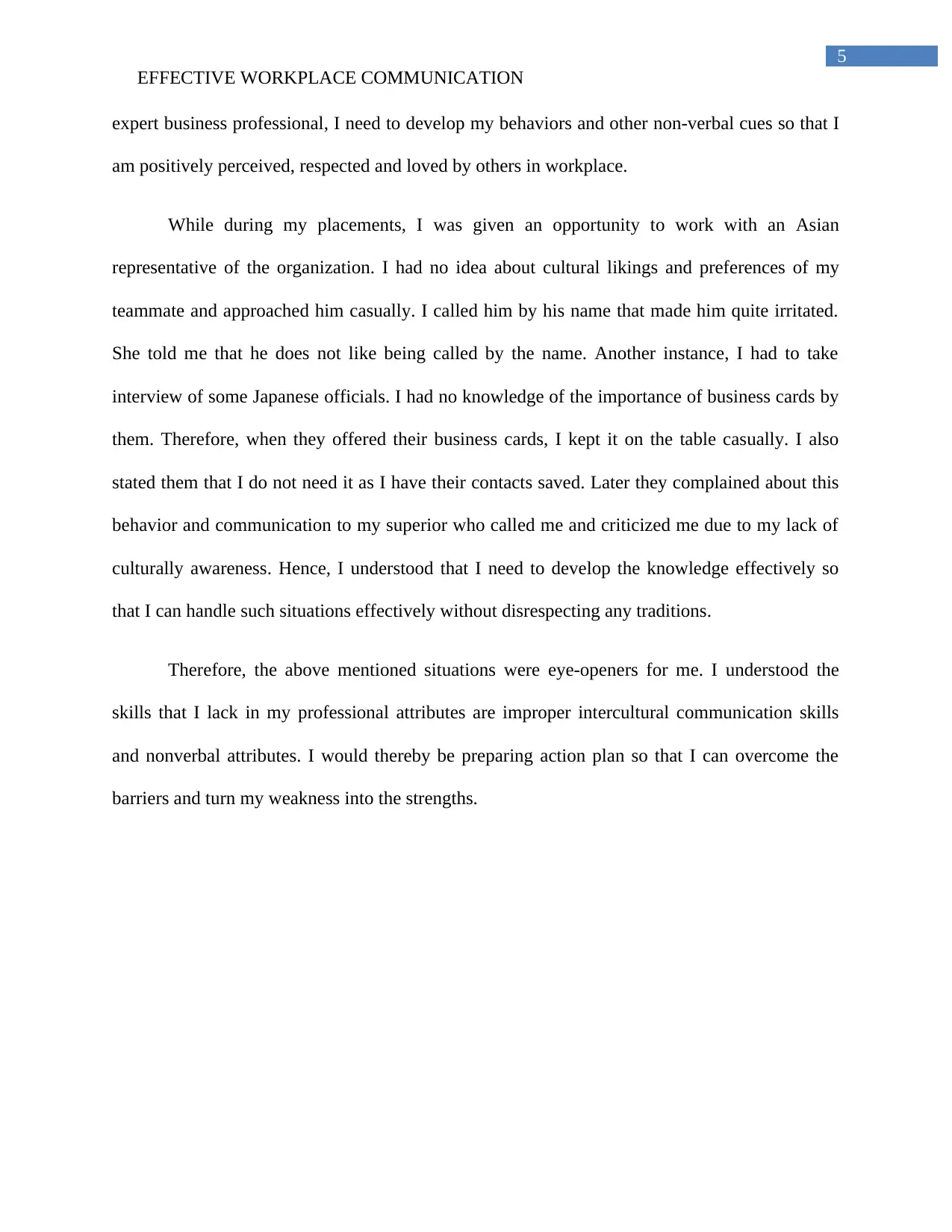
5
EFFECTIVE WORKPLACE COMMUNICATION
expert business professional, I need to develop my behaviors and other non-verbal cues so that I
am positively perceived, respected and loved by others in workplace.
While during my placements, I was given an opportunity to work with an Asian
representative of the organization. I had no idea about cultural likings and preferences of my
teammate and approached him casually. I called him by his name that made him quite irritated.
She told me that he does not like being called by the name. Another instance, I had to take
interview of some Japanese officials. I had no knowledge of the importance of business cards by
them. Therefore, when they offered their business cards, I kept it on the table casually. I also
stated them that I do not need it as I have their contacts saved. Later they complained about this
behavior and communication to my superior who called me and criticized me due to my lack of
culturally awareness. Hence, I understood that I need to develop the knowledge effectively so
that I can handle such situations effectively without disrespecting any traditions.
Therefore, the above mentioned situations were eye-openers for me. I understood the
skills that I lack in my professional attributes are improper intercultural communication skills
and nonverbal attributes. I would thereby be preparing action plan so that I can overcome the
barriers and turn my weakness into the strengths.
EFFECTIVE WORKPLACE COMMUNICATION
expert business professional, I need to develop my behaviors and other non-verbal cues so that I
am positively perceived, respected and loved by others in workplace.
While during my placements, I was given an opportunity to work with an Asian
representative of the organization. I had no idea about cultural likings and preferences of my
teammate and approached him casually. I called him by his name that made him quite irritated.
She told me that he does not like being called by the name. Another instance, I had to take
interview of some Japanese officials. I had no knowledge of the importance of business cards by
them. Therefore, when they offered their business cards, I kept it on the table casually. I also
stated them that I do not need it as I have their contacts saved. Later they complained about this
behavior and communication to my superior who called me and criticized me due to my lack of
culturally awareness. Hence, I understood that I need to develop the knowledge effectively so
that I can handle such situations effectively without disrespecting any traditions.
Therefore, the above mentioned situations were eye-openers for me. I understood the
skills that I lack in my professional attributes are improper intercultural communication skills
and nonverbal attributes. I would thereby be preparing action plan so that I can overcome the
barriers and turn my weakness into the strengths.
⊘ This is a preview!⊘
Do you want full access?
Subscribe today to unlock all pages.

Trusted by 1+ million students worldwide

6
EFFECTIVE WORKPLACE COMMUNICATION
According to research studies, immediacy in communication refers to the way by which
an individual signals willingness, closeness, and positive feelings towards others (Kreps &
Neuhauser, 2013). Thus, immediacy involves both verbal and non-verbal behaviours or actions,
which facilitate simultaneous communication of involvement, warmth, positive affect and
psychological closeness. Evidences suggest that nonverbal immediacy is imperative to the way
of interaction between different people, and also helps in evaluating their behaviour (Miller et
al., 2014). It has been considered as a central concept in studies that focused on instructional
communication. Findings further emphasise on teachers who are rated as nonverbally immediate,
being viewed more favourably by students (Kerssen-Griep & Witt, 2012).
Thus, this immediacy assists the concerned individual to maintain close relationship
owing to the fact that it establishes a sense of involvement, care and affection between people,
thereby enhancing intimate feelings (Fallah, 2014). Studies have been conducted that examined
the role of perceptions of a student related to nonverbal immediacy and clarity of their teachers.
Results from such studies focused on structural equations that illustrated the role of nonverbal
immediacy behaviour on influencing learning skills and perceptions of the students (Finn &
Schrodt, 2012). Furthermore, effects of such nonverbal immediacy behaviour have demonstrated
significant learning gains in children during a human-robot interaction (Kennedy et al., 2015).
Generally, nonverbal immediacy behaviours include reduction of physical distance between
individuals by touching (haptics), using gestures, smiling, displaying relaxed posture, vocal
variety and engaging in direct eye contact (oculesics). It also encompasses several aspects of
chronemics or use of time (Bodie & Jones, 2012).
Most nonverbal interaction between individuals are classified according to three basic
areas, namely, physical characteristics of key communicators, behaviours displayed by the
EFFECTIVE WORKPLACE COMMUNICATION
According to research studies, immediacy in communication refers to the way by which
an individual signals willingness, closeness, and positive feelings towards others (Kreps &
Neuhauser, 2013). Thus, immediacy involves both verbal and non-verbal behaviours or actions,
which facilitate simultaneous communication of involvement, warmth, positive affect and
psychological closeness. Evidences suggest that nonverbal immediacy is imperative to the way
of interaction between different people, and also helps in evaluating their behaviour (Miller et
al., 2014). It has been considered as a central concept in studies that focused on instructional
communication. Findings further emphasise on teachers who are rated as nonverbally immediate,
being viewed more favourably by students (Kerssen-Griep & Witt, 2012).
Thus, this immediacy assists the concerned individual to maintain close relationship
owing to the fact that it establishes a sense of involvement, care and affection between people,
thereby enhancing intimate feelings (Fallah, 2014). Studies have been conducted that examined
the role of perceptions of a student related to nonverbal immediacy and clarity of their teachers.
Results from such studies focused on structural equations that illustrated the role of nonverbal
immediacy behaviour on influencing learning skills and perceptions of the students (Finn &
Schrodt, 2012). Furthermore, effects of such nonverbal immediacy behaviour have demonstrated
significant learning gains in children during a human-robot interaction (Kennedy et al., 2015).
Generally, nonverbal immediacy behaviours include reduction of physical distance between
individuals by touching (haptics), using gestures, smiling, displaying relaxed posture, vocal
variety and engaging in direct eye contact (oculesics). It also encompasses several aspects of
chronemics or use of time (Bodie & Jones, 2012).
Most nonverbal interaction between individuals are classified according to three basic
areas, namely, physical characteristics of key communicators, behaviours displayed by the
Paraphrase This Document
Need a fresh take? Get an instant paraphrase of this document with our AI Paraphraser
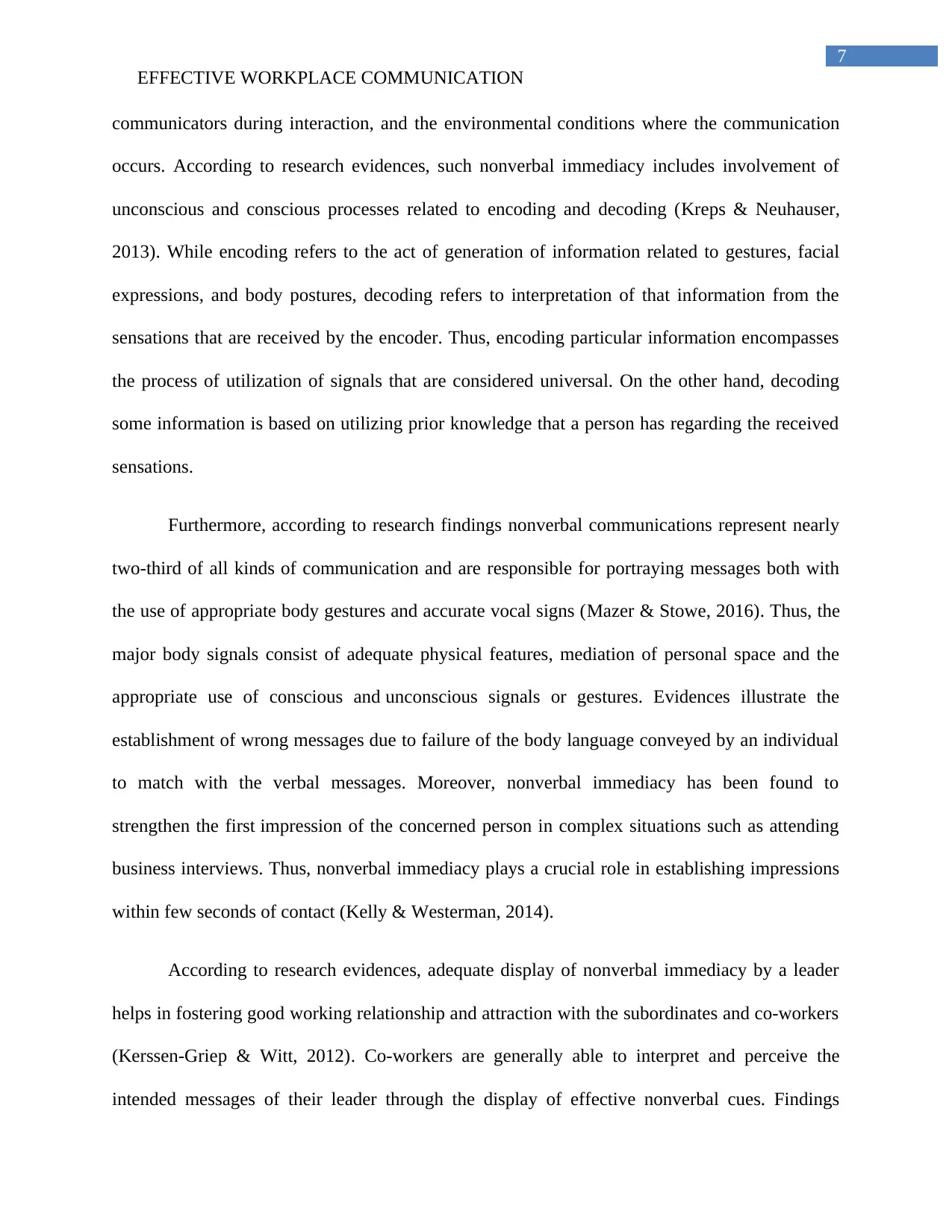
7
EFFECTIVE WORKPLACE COMMUNICATION
communicators during interaction, and the environmental conditions where the communication
occurs. According to research evidences, such nonverbal immediacy includes involvement of
unconscious and conscious processes related to encoding and decoding (Kreps & Neuhauser,
2013). While encoding refers to the act of generation of information related to gestures, facial
expressions, and body postures, decoding refers to interpretation of that information from the
sensations that are received by the encoder. Thus, encoding particular information encompasses
the process of utilization of signals that are considered universal. On the other hand, decoding
some information is based on utilizing prior knowledge that a person has regarding the received
sensations.
Furthermore, according to research findings nonverbal communications represent nearly
two-third of all kinds of communication and are responsible for portraying messages both with
the use of appropriate body gestures and accurate vocal signs (Mazer & Stowe, 2016). Thus, the
major body signals consist of adequate physical features, mediation of personal space and the
appropriate use of conscious and unconscious signals or gestures. Evidences illustrate the
establishment of wrong messages due to failure of the body language conveyed by an individual
to match with the verbal messages. Moreover, nonverbal immediacy has been found to
strengthen the first impression of the concerned person in complex situations such as attending
business interviews. Thus, nonverbal immediacy plays a crucial role in establishing impressions
within few seconds of contact (Kelly & Westerman, 2014).
According to research evidences, adequate display of nonverbal immediacy by a leader
helps in fostering good working relationship and attraction with the subordinates and co-workers
(Kerssen-Griep & Witt, 2012). Co-workers are generally able to interpret and perceive the
intended messages of their leader through the display of effective nonverbal cues. Findings
EFFECTIVE WORKPLACE COMMUNICATION
communicators during interaction, and the environmental conditions where the communication
occurs. According to research evidences, such nonverbal immediacy includes involvement of
unconscious and conscious processes related to encoding and decoding (Kreps & Neuhauser,
2013). While encoding refers to the act of generation of information related to gestures, facial
expressions, and body postures, decoding refers to interpretation of that information from the
sensations that are received by the encoder. Thus, encoding particular information encompasses
the process of utilization of signals that are considered universal. On the other hand, decoding
some information is based on utilizing prior knowledge that a person has regarding the received
sensations.
Furthermore, according to research findings nonverbal communications represent nearly
two-third of all kinds of communication and are responsible for portraying messages both with
the use of appropriate body gestures and accurate vocal signs (Mazer & Stowe, 2016). Thus, the
major body signals consist of adequate physical features, mediation of personal space and the
appropriate use of conscious and unconscious signals or gestures. Evidences illustrate the
establishment of wrong messages due to failure of the body language conveyed by an individual
to match with the verbal messages. Moreover, nonverbal immediacy has been found to
strengthen the first impression of the concerned person in complex situations such as attending
business interviews. Thus, nonverbal immediacy plays a crucial role in establishing impressions
within few seconds of contact (Kelly & Westerman, 2014).
According to research evidences, adequate display of nonverbal immediacy by a leader
helps in fostering good working relationship and attraction with the subordinates and co-workers
(Kerssen-Griep & Witt, 2012). Co-workers are generally able to interpret and perceive the
intended messages of their leader through the display of effective nonverbal cues. Findings

8
EFFECTIVE WORKPLACE COMMUNICATION
indicate that a leader’s job usually involves creating a productive and innovative organization,
which is accomplished through display of effective verbal and nonverbal skills. This in turn
helps the leader to communicate the purpose, vision, and direction of the department or
organization. Use of specific nonverbal cues creates better provisions for the leader to get the
verbal messages accepted by the co-workers.
According to research evidences, some iconic gestures play an essential role in conveying
exact meanings (Bodie & Jones, 2012). Such nonverbal skills have also been found to serve
several functions such as, substitution, repetition, accenting, and complement. Thus, owing to the
fact that non-verbal communications comprise more than 90% information that glean from
individuals, there has been an increase in social psychological researches that focus on confident
use of physicality for a clear and trust-inducing communication. The sign theory focuses on 3
fields namely, syntactic, semantics and pragmatics. While, semantics focus on use of signs as
designators, syntactics and pragmatics refer to the organization of the aforementioned signs into
system and their use in everyday life, respectively (Palmer et al., 2012).
Moreover, according to the theory proposed by anthropologist Edward Hall, proxemics
was considered as an important aspect of nonverbal skills. It refers to the study that illustrates
construction and management of microspace or distance between individuals during everyday
transactions (Marquardt & Greenberg, 2012). In addition, Albert Mehrabian's communication
model suggested that words make up negligible amount of direct communication. On the other
hand, facial expression and non-lexical elements form the foundation of nonverbal
communication (Velez & Cano, 2012).
EFFECTIVE WORKPLACE COMMUNICATION
indicate that a leader’s job usually involves creating a productive and innovative organization,
which is accomplished through display of effective verbal and nonverbal skills. This in turn
helps the leader to communicate the purpose, vision, and direction of the department or
organization. Use of specific nonverbal cues creates better provisions for the leader to get the
verbal messages accepted by the co-workers.
According to research evidences, some iconic gestures play an essential role in conveying
exact meanings (Bodie & Jones, 2012). Such nonverbal skills have also been found to serve
several functions such as, substitution, repetition, accenting, and complement. Thus, owing to the
fact that non-verbal communications comprise more than 90% information that glean from
individuals, there has been an increase in social psychological researches that focus on confident
use of physicality for a clear and trust-inducing communication. The sign theory focuses on 3
fields namely, syntactic, semantics and pragmatics. While, semantics focus on use of signs as
designators, syntactics and pragmatics refer to the organization of the aforementioned signs into
system and their use in everyday life, respectively (Palmer et al., 2012).
Moreover, according to the theory proposed by anthropologist Edward Hall, proxemics
was considered as an important aspect of nonverbal skills. It refers to the study that illustrates
construction and management of microspace or distance between individuals during everyday
transactions (Marquardt & Greenberg, 2012). In addition, Albert Mehrabian's communication
model suggested that words make up negligible amount of direct communication. On the other
hand, facial expression and non-lexical elements form the foundation of nonverbal
communication (Velez & Cano, 2012).
⊘ This is a preview!⊘
Do you want full access?
Subscribe today to unlock all pages.

Trusted by 1+ million students worldwide
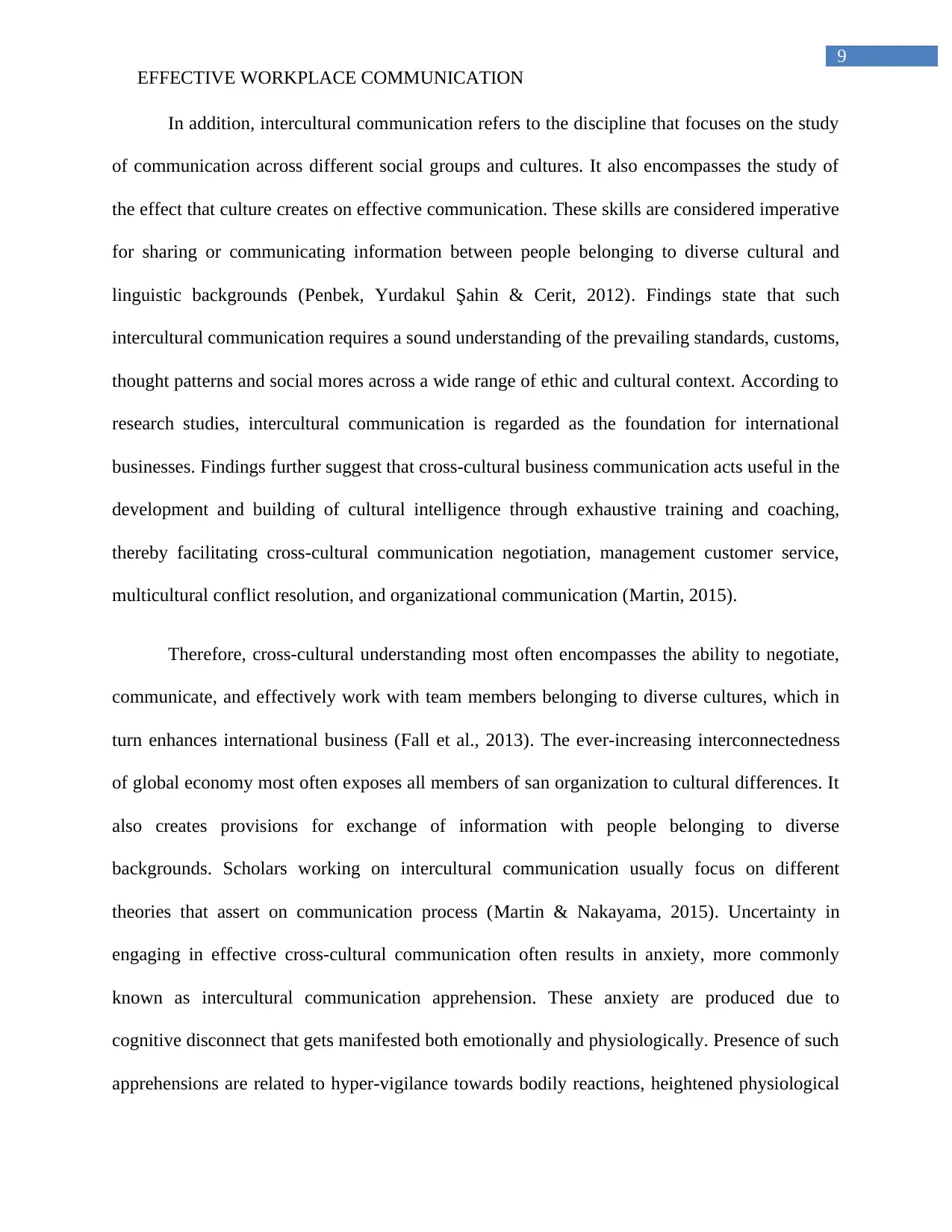
9
EFFECTIVE WORKPLACE COMMUNICATION
In addition, intercultural communication refers to the discipline that focuses on the study
of communication across different social groups and cultures. It also encompasses the study of
the effect that culture creates on effective communication. These skills are considered imperative
for sharing or communicating information between people belonging to diverse cultural and
linguistic backgrounds (Penbek, Yurdakul Şahin & Cerit, 2012). Findings state that such
intercultural communication requires a sound understanding of the prevailing standards, customs,
thought patterns and social mores across a wide range of ethic and cultural context. According to
research studies, intercultural communication is regarded as the foundation for international
businesses. Findings further suggest that cross-cultural business communication acts useful in the
development and building of cultural intelligence through exhaustive training and coaching,
thereby facilitating cross-cultural communication negotiation, management customer service,
multicultural conflict resolution, and organizational communication (Martin, 2015).
Therefore, cross-cultural understanding most often encompasses the ability to negotiate,
communicate, and effectively work with team members belonging to diverse cultures, which in
turn enhances international business (Fall et al., 2013). The ever-increasing interconnectedness
of global economy most often exposes all members of san organization to cultural differences. It
also creates provisions for exchange of information with people belonging to diverse
backgrounds. Scholars working on intercultural communication usually focus on different
theories that assert on communication process (Martin & Nakayama, 2015). Uncertainty in
engaging in effective cross-cultural communication often results in anxiety, more commonly
known as intercultural communication apprehension. These anxiety are produced due to
cognitive disconnect that gets manifested both emotionally and physiologically. Presence of such
apprehensions are related to hyper-vigilance towards bodily reactions, heightened physiological
EFFECTIVE WORKPLACE COMMUNICATION
In addition, intercultural communication refers to the discipline that focuses on the study
of communication across different social groups and cultures. It also encompasses the study of
the effect that culture creates on effective communication. These skills are considered imperative
for sharing or communicating information between people belonging to diverse cultural and
linguistic backgrounds (Penbek, Yurdakul Şahin & Cerit, 2012). Findings state that such
intercultural communication requires a sound understanding of the prevailing standards, customs,
thought patterns and social mores across a wide range of ethic and cultural context. According to
research studies, intercultural communication is regarded as the foundation for international
businesses. Findings further suggest that cross-cultural business communication acts useful in the
development and building of cultural intelligence through exhaustive training and coaching,
thereby facilitating cross-cultural communication negotiation, management customer service,
multicultural conflict resolution, and organizational communication (Martin, 2015).
Therefore, cross-cultural understanding most often encompasses the ability to negotiate,
communicate, and effectively work with team members belonging to diverse cultures, which in
turn enhances international business (Fall et al., 2013). The ever-increasing interconnectedness
of global economy most often exposes all members of san organization to cultural differences. It
also creates provisions for exchange of information with people belonging to diverse
backgrounds. Scholars working on intercultural communication usually focus on different
theories that assert on communication process (Martin & Nakayama, 2015). Uncertainty in
engaging in effective cross-cultural communication often results in anxiety, more commonly
known as intercultural communication apprehension. These anxiety are produced due to
cognitive disconnect that gets manifested both emotionally and physiologically. Presence of such
apprehensions are related to hyper-vigilance towards bodily reactions, heightened physiological
Paraphrase This Document
Need a fresh take? Get an instant paraphrase of this document with our AI Paraphraser

10
EFFECTIVE WORKPLACE COMMUNICATION
arousal, perceived loss of control, fear of visual scrutiny and of revealing the anxious state
(Neuliep, 2012).
With an increase in such apprehension, individuals demonstrate less susceptibility to
participate in interactions. This in turn reduces tolerance levels and increases contempt towards
co-workers of different culture (Mak, Brown & Wadey, 2014). Evidences also suggest that men
are always at an increased likelihood of experiencing intercultural communication apprehension,
upon comparison with women (Godwin-Jones, 2013). Moreover, although individuals with
increased apprehension levels have been found to demonstrate low communication competence
at the workplace, an elevation in cultural awareness often decreases associated apprehensions.
The Uncertainty Management Theory (AUM) focuses on negative effects of intercultural
communication and ethnocentrism on encounter satisfaction. According to research findings,
educational level, gender and age have shown negligible effects on such apprehension. However,
frequency of communication in proficient English acts as a major contributing factor (Han,
2013). The cultural convergence theory refers to the fact that in a relatively closed social system
with unrestricted communication, the entire system shows a tendency to converge towards a state
of cultural uniformity (Kahan, 2012).
Moreover, the co-cultural theory evaluates the strategic ways that can be used by team
members to communicate with each other (Orbe & Roberts, 2012). Furthermore, the standpoint
theory illustrates the influence of the social group to which an individual belongs, on the
knowledge and experience of communication behaviours (Edwards, 2014). Therefore, research
studies emphasise on the use of appropriate words, gestures, pictures and avoidance of regional
saying and slangs for an effective cross-cultural communication. Therefore, demonstration of
competence with regards to nonverbal skills and intercultural communication are essential for an
EFFECTIVE WORKPLACE COMMUNICATION
arousal, perceived loss of control, fear of visual scrutiny and of revealing the anxious state
(Neuliep, 2012).
With an increase in such apprehension, individuals demonstrate less susceptibility to
participate in interactions. This in turn reduces tolerance levels and increases contempt towards
co-workers of different culture (Mak, Brown & Wadey, 2014). Evidences also suggest that men
are always at an increased likelihood of experiencing intercultural communication apprehension,
upon comparison with women (Godwin-Jones, 2013). Moreover, although individuals with
increased apprehension levels have been found to demonstrate low communication competence
at the workplace, an elevation in cultural awareness often decreases associated apprehensions.
The Uncertainty Management Theory (AUM) focuses on negative effects of intercultural
communication and ethnocentrism on encounter satisfaction. According to research findings,
educational level, gender and age have shown negligible effects on such apprehension. However,
frequency of communication in proficient English acts as a major contributing factor (Han,
2013). The cultural convergence theory refers to the fact that in a relatively closed social system
with unrestricted communication, the entire system shows a tendency to converge towards a state
of cultural uniformity (Kahan, 2012).
Moreover, the co-cultural theory evaluates the strategic ways that can be used by team
members to communicate with each other (Orbe & Roberts, 2012). Furthermore, the standpoint
theory illustrates the influence of the social group to which an individual belongs, on the
knowledge and experience of communication behaviours (Edwards, 2014). Therefore, research
studies emphasise on the use of appropriate words, gestures, pictures and avoidance of regional
saying and slangs for an effective cross-cultural communication. Therefore, demonstration of
competence with regards to nonverbal skills and intercultural communication are essential for an

11
EFFECTIVE WORKPLACE COMMUNICATION
effective leadership. Proper manifestation of the aforementioned skills helps in managing
conflicts at workplace and facilitates easy accomplishment of the intended goals or objectives of
the organization (Oommen, 2014).
EFFECTIVE WORKPLACE COMMUNICATION
effective leadership. Proper manifestation of the aforementioned skills helps in managing
conflicts at workplace and facilitates easy accomplishment of the intended goals or objectives of
the organization (Oommen, 2014).
⊘ This is a preview!⊘
Do you want full access?
Subscribe today to unlock all pages.

Trusted by 1+ million students worldwide
1 out of 30
Related Documents
Your All-in-One AI-Powered Toolkit for Academic Success.
+13062052269
info@desklib.com
Available 24*7 on WhatsApp / Email
![[object Object]](/_next/static/media/star-bottom.7253800d.svg)
Unlock your academic potential
Copyright © 2020–2025 A2Z Services. All Rights Reserved. Developed and managed by ZUCOL.




